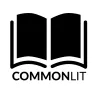Take a look inside 5 images
CommonLit
Pros: Leveled texts, new target lessons, and formative data make it easy to tailor the experience. Guiding, assessment, and discussion questions as well as annotations offer layers of learning.
Cons: Students will need some help to get the most out of the toolbar. Older and more advanced students may tire of the assessment format if not tailored for or by them.
Bottom Line: Access a hefty collection of reliable, ready-to-print, leveled passages that allow you to tailor lessons, assign online reading, and track progress.
CommonLit is a treasure trove of literary resources that teachers can use to build lessons that target students' reading needs. Use the robust search and filter tool to explore texts by themes like America, Education, Family, and Friendship, Prejudice and Discrimination, Resilience, and Growing Up. Or, search by genre or literary device. Looking for a specific grade or Lexile level passage? Use that filter. Need to pair it with an emerging or challenging text? Click the Paired Text tab. Teachers pressed for time can skip to the Text Set filter and select one of the 50 options organized by historical period or literary movement and find a variety of texts at a variety of reading levels -- news stories, articles, speeches, poetry, and short stories -- ready to use.
The new Target Lesson filter is another time-saver when needing to check student proficiency.
Once teachers have found a passage, they can download a PDF or assign it to students (either groups or individuals), setting a time window for completion. All passages are accompanied by assessment and discussion questions; teachers can also opt to enable a Guided Reading mode to get students answering comprehension questions as they read. The annotation feature allows students to highlight parts of the text and add their commentary and questions. Teachers can ask students to make use of this tool and review the annotations later.
CommonLit is a free digital library of leveled texts: news articles, poems, short stories, and historical documents. You can filter collections by grade level, Lexile level, theme, genre, literary device, even Common Core State Standards. Or, use the over 50 curated text sets organized by historical period or literary movement. Every passage comes with an introduction with essential background information, and footnotes with vocabulary words.
Teachers searching for complete reading sets and targeted support in Spanish will enjoy the variety and range available.
And, new teachers and those seeking support with planning will appreciate the CommonLit 360 Curriculum tab which features nearly a year's worth of multi-genre units.
Middle school teachers should keep an eye out for the 2.0 edition of CommonLit 360 for Middle School due to launch in July 2023.
Texts have a variety of accessibility and learning tools. There's a text-to-speech button that reads passages aloud; translation for over 13 languages, including Arabic, Chinese Spanish, Russian, and Vietnamese; and a highlighting/annotation tool for active reading. Teachers can review students' annotations afterward to gauge student comprehension. Alongside texts are a variety of question sets: guiding, assessment, and discussion. Assessment questions range from multiple choice to short answer, and the discussion questions focus on tapping into students’ critical thinking. Many of the passages and text sets also feature a guiding questions section (which can be enabled by teachers when assigning texts). These questions must be answered for students to progress. Along with these questions, texts offer extension resources like at-home learning suggestions and associated media.
Students and teachers can sign up for free accounts. The site supports integration with Google Classroom and Clever, making uploading student information all the easier. Teacher accounts include an easy-to-navigate teacher dashboard that allows you to create multiple classes, assign reading passages to students, score responses to questions, and track progress for an entire class or an individual student. Student data is gathered and displayed in colorful, easy-to-follow visuals that include graphs, tables, and charts. At the bottom of the teacher dashboard, you'll even find a list of students who need to be challenged more and those who may need further remediation.
CommonLit makes reading accessible for students at a variety of reading levels and language abilities. It's perfect for English-language learners and struggling readers. Every passage -- printed in PDF format or accessed online -- includes footnotes with vocabulary words and essential background information that's critical for kids to understand when reading the passage. The range of questions, along with the ability to annotate and comment on reading, check students' understanding, challenge them to engage with texts, and move them toward thinking critically about what they read and their world. The whole experience is perfectly aligned with teachers' curricular needs and what students need in order to grow as readers. The one missing piece is adjustable reading levels for each text. Teachers, however, can assign different texts to different students so that students are working at an appropriately challenging level.
Learning can be extended even further through the use of the suggested paired texts, related media, and useful suggestions to engage parents and extend learning at home. These resources lend themselves well to building students' background knowledge on a specific topic. They're also a great choice for homework assignments, remediation, and extension activities around the same topic. There's a range in quality, though, so teachers might find themselves searching for their own supplements.














